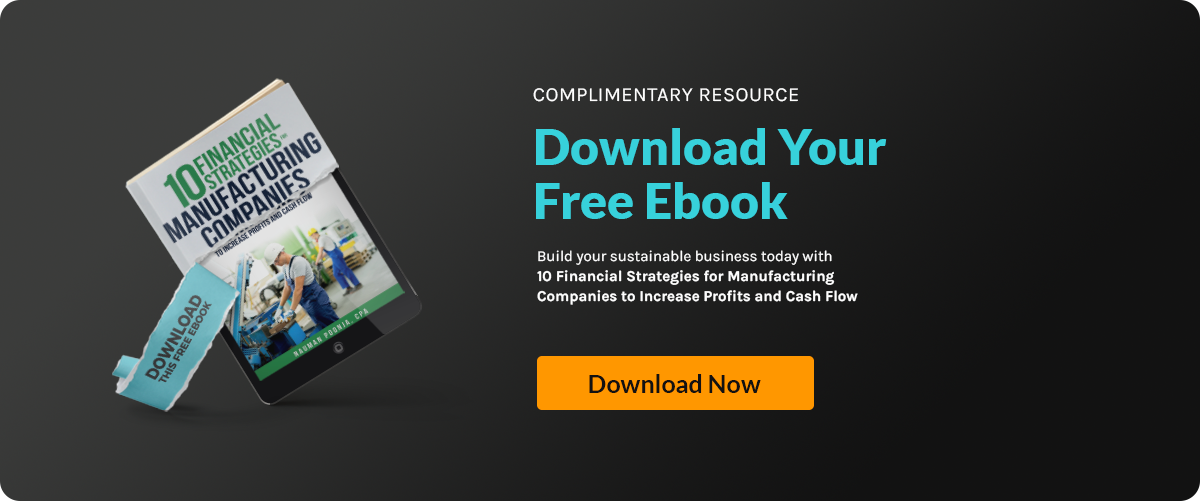Manufacturers today face rising costs, supply chain disruptions, and unpredictable demand....
Maximize Your Return on Invested Capital (ROIC) in Manufacturing

Return on Invested Capital (ROIC) is one of the most powerful financial metrics manufacturers can use to measure true performance. It tells you how effectively your business is turning capital into profit—and whether your investments are actually paying off.
Many manufacturers focus on boosting revenue or cutting costs, but those strategies can miss the bigger picture. ROIC connects operational decisions to bottom-line outcomes by evaluating how much return you’re generating for every dollar invested. Whether you’re scaling production, upgrading equipment, or entering new markets, ROIC gives you a clearer lens through which to make smarter decisions.
What Is ROIC and Why Does It Matter in Manufacturing?
ROIC is a profitability ratio that measures how efficiently a company uses its capital—both equity and debt—to generate operating profits. It stands apart from other return metrics like Return on Assets (ROA) and Return on Equity (ROE) because it provides a more comprehensive view. While ROA focuses only on total assets and ROE concentrates on shareholders’ equity, ROIC blends both debt and equity, making it a more complete measure of how well the business is utilizing all available capital. In manufacturing, where capital investment is substantial, this holistic view is especially critical. (both equity and debt) to generate returns. It is calculated as:
ROIC = Net Operating Profit After Tax (NOPAT) / Invested Capital
This formula captures the relationship between your operating profit and the total capital deployed to run your business. Unlike other performance metrics, ROIC strips away accounting noise and shows how well your capital is working for you.
In manufacturing—where capital expenditures are high and margins can be tight—ROIC is especially important. It gives a clearer picture than broad profitability ratios or top line vs. bottom line comparisons because it isolates how your investments (machinery, facilities, systems) are driving return.
Companies with high ROIC tend to have:
- Strong pricing power
- Efficient cost control
- High asset utilization
- Better access to funding
ROIC isn’t just about how much profit you make—it’s about how effectively you generate profit relative to the resources you’ve deployed.
Key Components of ROIC in Manufacturing
Improving ROIC starts by understanding the two core components: NOPAT and Invested Capital.
Net Operating Profit After Tax (NOPAT)
This is your operating income after taxes. It reflects true business performance before financing decisions or accounting adjustments.
NOPAT can be improved by:
- Increasing operating efficiency
- Raising gross margins
- Reducing fixed overhead
- Eliminating waste in production
Tools like margin analysis can help isolate underperforming product lines or plants, giving you the clarity to act decisively.
Invested Capital
This includes the total capital invested in the business through:
- Equity contributions
- Retained earnings
- Long-term debt
It also includes:
- Net working capital (accounts receivable + inventory - accounts payable)
- Net fixed assets (property, plant, equipment)
Reducing capital tied up in unproductive assets or excess inventory is critical to improving ROIC. For example, if your manufacturing operation maintains inventory levels that exceed your average monthly demand by 30–40%, you're tying up significant working capital that could be redirected into higher-yield projects. Similarly, idle machinery or outdated equipment not only adds depreciation but inflates your invested capital denominator—diluting ROIC even if your operating profit is healthy. Quantifying these inefficiencies gives you the data to act decisively.
Strategies to Maximize ROIC in Manufacturing
Improving ROIC doesn’t require radical restructuring. Most gains come from tightening processes, improving visibility, and making more strategic use of resources. Here’s how:
1. Optimize Capital Allocation
Review your current capital deployment. Are your investments yielding returns, or are they just consuming cash? Using capital expenditure planning tools allows manufacturers to prioritize high-ROI projects while deferring or scrapping inefficient ones.
When equipment upgrades, tech implementation, or expansion projects are aligned with long-term ROI, your capital works harder—and smarter.
2. Improve Operating Efficiency
ROIC is sensitive to both revenue and cost. Process improvements that increase throughput without requiring significant capital outlay drive ROIC up. Lean manufacturing, labor cost control strategies, and smart scheduling reduce overhead and boost productivity.
Using insights from capacity and production planning, manufacturers can align labor, materials, and machine usage with demand, eliminating underutilized resources.
3. Reduce Working Capital Requirements
Working capital ties up cash. Excess inventory, slow receivables, or overproduction can drag down ROIC. Implementing ERP systems improves visibility into inventory turnover, supplier terms, and order cycles—freeing up capital trapped in operations.
Combining accurate forecasting with production discipline is key. For example, applying rolling forecasting techniques ensures resources are adjusted as conditions evolve, not months later.
4. Maximize Asset Utilization
Your equipment should work as hard as your people. High fixed asset costs can dilute ROIC if utilization is low. Conducting financial health checks can uncover underperforming assets and maintenance gaps.
Reallocating or divesting idle machinery can reduce your asset base while maintaining output, instantly improving ROIC.
5. Leverage R&D and Tax Incentives
Manufacturers investing in process improvement or product innovation may qualify for R&D tax credits or other incentive programs. These incentives can significantly reduce your tax burden and effectively increase your net return on capital—without requiring any additional investment.
It's important to understand that many of these programs vary by region, industry, and even company size. For instance, some states in the U.S. offer aggressive incentives for advanced manufacturing or clean energy upgrades, while others focus on job creation or export growth. Working with a knowledgeable advisor or finance team can help identify which credits your business qualifies for, and how to document eligible activities properly. Leveraging these programs is one of the most overlooked yet impactful strategies to boost ROIC in the near term.
Manufacturers investing in process improvement or product innovation may qualify for R&D tax credits or other incentive programs. These benefits reduce tax burdens and increase net return without increasing invested capital.
Understanding which activities qualify—and documenting them effectively—can unlock cash savings and lift ROIC in the near term.
6. Strengthen Pricing and Product Mix
Revenue growth that doesn’t require proportional capital increases will lift ROIC. That’s why pricing strategy is critical. Products with low margins or high complexity often deliver poor returns.
Using tools like cost-volume-profit analysis helps identify which products are truly profitable and which are capital drains.
Focusing on high-margin, low-capital products can deliver higher ROIC without expanding your cost base.
How ROIC Guides Smarter Decision-Making
Unlike one-dimensional metrics like net income or gross margin, ROIC reflects the full scope of financial stewardship. It helps executives and investors evaluate:
- Whether growth is profitable
- How quickly investments pay off
- When to reinvest vs. divest
For example, two business units may show similar profits, but if one uses twice the capital to generate it, its ROIC—and value creation—is far lower.
ROIC also helps prioritize competing opportunities. Whether you’re considering a factory expansion or hiring a fractional CFO, ROIC forces a comparison of expected return against required investment.
Common Pitfalls That Lower ROIC
Even strong companies fall into ROIC traps. Watch out for these:
Overbuilding Inventory
Too much inventory inflates working capital. This is a silent killer of ROIC—especially when slow-moving stock ties up resources.
Investing Without a Clear ROI
Major expenditures on technology or facilities must be justified with expected returns. ROIC helps prevent “nice-to-have” spending that doesn’t deliver.
Poor Overhead Control
Bloated overhead eats into NOPAT and limits ROIC. Streamlining functions and using modern financial automation tools can help.
Failing to Retire Low-Return Assets
Holding on to underutilized or outdated assets increases invested capital without generating additional returns.
How to Track and Improve ROIC Over Time
Improving ROIC isn’t a one-time event. It requires consistent measurement, internal benchmarking, and refinement. Here’s how to build it into your operations:
- Establish Baselines: Start by calculating current ROIC by product line, business unit, or plant.
- Link ROIC to KPIs: Integrate ROIC goals with other metrics like EBITDA, margin per unit, and throughput.
- Conduct Regular Reviews: Use rolling forecasts and quarterly reviews to adjust course.
- Use a Dashboard: Build dashboards that track NOPAT and capital deployed in real-time.
- Educate Leadership: Ensure operational and finance leaders understand how their decisions impact ROIC.
Embedding ROIC into everyday thinking aligns your team around outcomes, not just activity. One effective way to make this cultural shift is by integrating ROIC-based goals into team incentives and performance evaluations. For example, plant managers could be rewarded for increasing output without expanding capital assets, or finance teams might be measured on working capital improvements. When ROIC becomes a shared metric across departments—not just a boardroom figure—it fosters a more unified and strategic mindset throughout the organization.
Conclusion: Turn Capital into Competitive Advantage
Return on Invested Capital is more than a financial ratio—it’s a decision-making framework. When used correctly, it sharpens focus, prioritizes efficiency, and rewards smart growth.
In a capital-intensive industry like manufacturing, mastering ROIC can be the difference between steady growth and stalled progress. By aligning strategy, operations, and finance around ROIC, your company can move faster, use resources better, and build long-term value.
Want help improving ROIC in your manufacturing business? Contact Accounovation to explore how targeted financial strategies, operational insights, and capital planning tools can boost your returns and your confidence. Whether you're preparing for your next fiscal cycle or re-evaluating mid-year performance, the right adjustments today can elevate your return on invested capital significantly in the quarters ahead. to explore how targeted financial strategies, operational insights, and capital planning tools can boost your returns and your confidence.







